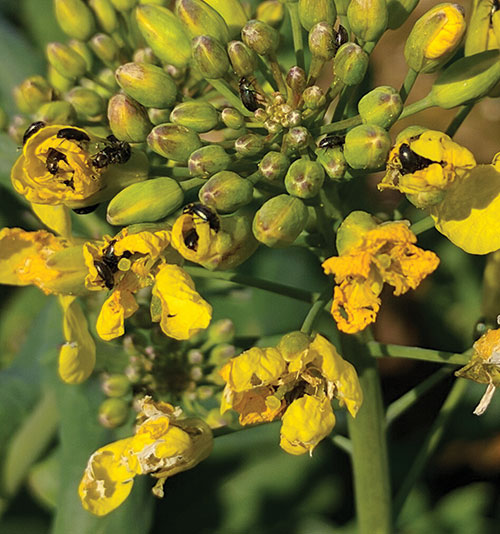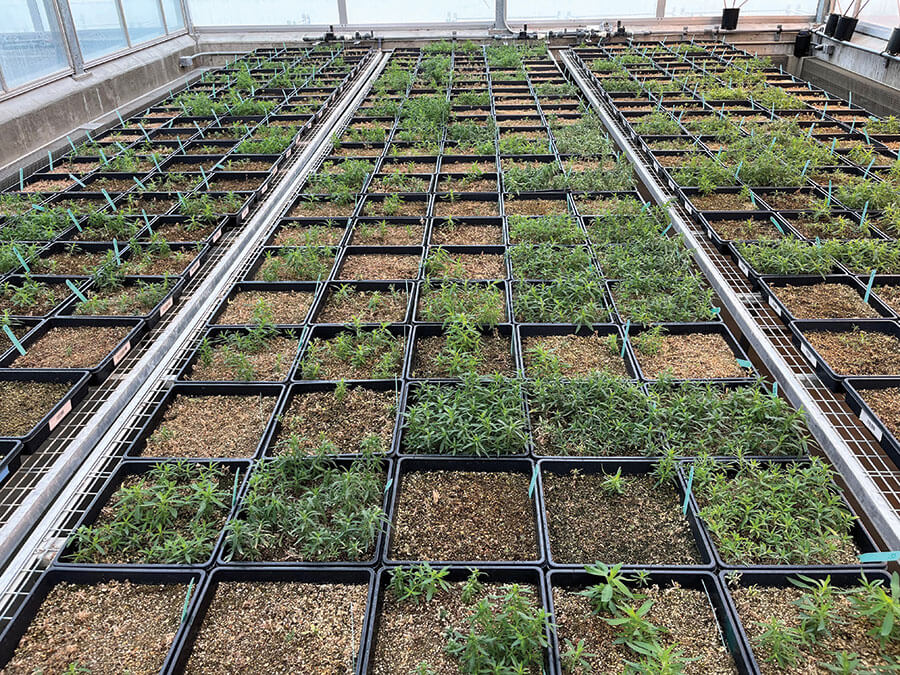Watch For These Potential New Pests
Canola acres on the Canadian Prairies exceeded 20 million in 2012 and have stayed above that threshold ever since. More acres attracts more pests. Milder winters and longer growing seasons also make the Prairies more hospitable to pests that may not have thrived before. Finally, farm practices can increase selection pressure for existing pests that are more more difficult to manage – glyphosate-resistant wild oats, for example. Because all of these pressure factors are in play – lots of canola acres, warmer climate and selection pressure – canola growers, pest specialists and agronomists are on the watch for new threats.
Here are a few of greatest concern.
Swede midge (Contarinia nasturtii) has been very damaging to canola in some areas of Ontario, especially the spring canola region of Temiskaming. Canola growers in that region often require multiple insecticide applications, and use crop rotation and distancing from previous infestations to assist in population control. Swede midge, if introduced in an area of the Prairies with the right moisture and heat, could thrive. The whitish yellow maggots (up to 3mm) feed within the growing point, and enzymes from their saliva impede proper growth and can cause deformities. The tiny brown swede midge fly looks like other closely related midges, including canola flower midge (Contarinia brassicola), which was officially identified on the Prairies in 2019. While widely distributed, canola flower midge has not yet caused economic concern. Find more on swede midge and canola flower midge in the Insect section at canolaencyclopedia.ca.
Pollen beetles. Two species (Brassicogethes aeneus and Brassicogethes viridescens) are part of the pollen beetle complex. They cause considerable damage to rapeseed crops in Europe, and could do the same to canola if the invasive species arrives on the Prairies. Bronzed blossom beetle (Brassicogethes viridescens) is established in Eastern Quebec and the Maritimes and has a reasonable adaptation to the Prairies. While not confirmed on the Prairies, be on the look out: they look like flea beetles and will be found inside flowers. Yield loss from pollen beetle complex is as high as 80 per cent in Europe. Adults feed on pollen, which in itself will reduce fertilization of flowers. Adults lay eggs in buds, and hatching larvae feed on buds. Feeding from adults and larvae will result in pod abortion.

Verticillium stripe (Verticillium longisporum) was first identified on the Prairies in 2014 and is already causing yield loss on some farms, especially in 2022. Warmer soil temperatures accelerates spread of this disease to stem vascular tissue and characteristic striping. Research continues to better understand the spread and severity of verticillium stripe within Canada, along with how to best manage the disease. Find more on verticillium in the Diseases section at canolaencyclopedia.ca.
Group-9-resistant weeds. In Western Canada, glyphosate herbicide is a highly effective tool for producers who practice conservation tillage. While minimum tillage and no-tillage benefit soil health, conserve soil moisture and improve yield, farmers who use this practice depend on Group-9 glyphosate to provide weed control. Group-9-resistant kochia is widespread on the Prairies, and Group-9-resistant downy brome was confirmed in 2021. Hugh Beckie, formerly of Agriculture and Agri-Food Canada, ranked wild oat (Avena fatua) as the most economically important weed in Western Canada, accounting for more crop yield losses and herbicide expenditures in Western Canada than any other weed. Back in 2011, Beckie forecast that wild oat, green foxtail (Setaria viridis) and cleavers (Galium aparin) were high risk to develop glyphosate resistance. Any one of those could cause severe yield loss in canola and other crops. The challenge moving forward is to find suitable herbicide alternatives so farmers can reduce their reliance on herbicides to control unwanted weed species. Read the article on integrated weed management in the Weeds section at canolawatch.org/fundamentals.
What to do?
Changes are expected. New pests are inevitable. Higher temperatures and exceedingly variable precipitation anticipated with climate change will favour some canola diseases, make the Prairies hospitable to more insects, and may alter the distribution and abundance of weed species. Watch for changes in pest behaviour, look for unusual species and report different-looking damage to CCC agronomy specialists.
Proactive pest monitoring and surveillance identifies the extent of pest damage, advances in pest range and severity, and new pests. Unified surveillance efforts, led by government with cooperation from growers, must continue.
Changes in behaviour for existing pests and introduction of new pests will require adaptations in management. Effective action plans will require research and on-farm trial and error. Time required to improve practices is shortened when we all communicate effective and non-effective practices.
Ultimately, a flexible, evolving integrated pest management (IPM) approach is recommended. There is no single solution.
Watch for changes in pest behaviour, look for unusual species and report different-looking damage to
CCC agronomy specialists.
Management steps include crop rotation, use of protection products with different modes of action, cultivar resistance or tolerance, and strategic deployment of technology. For example, seed- and crop-applied insecticides can be effective control mechanisms, yet because of natural selection and species evolution, no single product or mode of action is effective over the long-term. Same with cultivar resistance. Disease resistance has maintained yield and reduced infection, however, this can be overcome by selection pressure. Research into genetic resistance and strategic deployment of resistance sources is required to reduce the risk of crop damage and future disease infections.
Finally, changes to national and foreign policy have the potential to limit control measures – such as pesticides and genetic tools – available to farmers. Research into the environmental and economic sustainability of canola production in the Canadian Prairies must continue to ensure a climate resilient crop.





